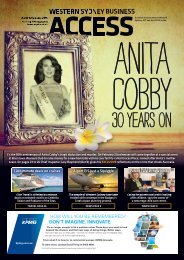RECRUITMENT
WSBA September 2015
WSBA September 2015
You also want an ePaper? Increase the reach of your titles
YUMPU automatically turns print PDFs into web optimized ePapers that Google loves.
FEATURE<br />
WWW.WSBA.COM.AU<br />
Is customer delight enough to inspire loyalty?<br />
Feeling connected is more important<br />
CUSTOMERS<br />
DELIVERING service so excellent that the<br />
customer’s expectations have been met<br />
and exceeded has long been the goal of<br />
businesses.<br />
On the scale of service, the aspirational<br />
pinnacle has been to delight the customer<br />
because delight, after all, is a step above excellence<br />
and way beyond plain satisfaction.<br />
Modern consumers like to identify strongly<br />
with the brands and businesses they engage<br />
with, and in many cases customers have a<br />
significant input into creating the experience<br />
through their own interaction with the brand,<br />
employees and other customers.<br />
More than ever before, customers are<br />
investing themselves in the brands they use.<br />
If the customer is delighted the business<br />
assumes they will come back again, and not<br />
only that, they will tell their friends and family<br />
about their experience, too.<br />
But while it might be the top of the<br />
service delivery hierarchy, does delighting the<br />
customer actually serve the ultimate purpose:<br />
which is to drive loyalty to the brand and<br />
ensure repeat business?<br />
It was in this context that three researchers<br />
from UNSW Business School decided to test<br />
the hypotheses that making customers “feel<br />
connected” might actually be more productive<br />
than making them “feel delighted”.<br />
Senior lecturer Mathew Chylinski and<br />
associate professor Liem Viet Ngo worked<br />
with PhD candidate Jake An to examine three<br />
real-life examples to discover whether delight<br />
or connectedness were the best drivers of<br />
loyalty.<br />
“Although 89% of service firms aim to<br />
delight customers by exceeding customers’ expectations,<br />
delighting customers does not lead<br />
to measurable gains in repurchase intention or<br />
word of mouth,” the team reports.<br />
New sensibility<br />
The researchers focused on three business<br />
operations where customers were heavily<br />
involved, and had a significant investment in<br />
the outcome through their own participation<br />
– higher degree research education at UNSW,<br />
a fitness gym, and a US online gaming community.<br />
Detailed questionnaires were created and<br />
distributed to each group, with 191 respondents<br />
from UNSW, 142 from the fitness gym,<br />
and 316 from the online gamers.<br />
“The initial position we had was to look at<br />
the different kinds of emotions customers can<br />
feel,” explains Ngo.<br />
“They can feel satisfied and delighted, but<br />
ultimately the goal is for them to feel connected<br />
and have an emotional attachment to<br />
the brand, and we wanted to understand what<br />
the drivers for this were.<br />
“And we wanted to look at examples where<br />
customers actively engage with the service,<br />
where they have to put in effort to receive an<br />
outcome, and understand which emotions are<br />
most influential in driving their loyalty.”<br />
According to Chylinski, the “new sensibility”<br />
in marketing is around engaging the<br />
customer.<br />
“Passive services have been well studied,<br />
but we wanted to study active participation<br />
where the customer has to put effort into<br />
the service to achieve some kind of outcome<br />
for themselves because active engagement<br />
is what both firms and customers strive for<br />
these days,” Chylinski says.<br />
Fellow researcher An makes the point that<br />
the customer can be “much more powerful<br />
than ever before largely due to social media<br />
and the internet”.<br />
“Customers today can be content creators<br />
and distributors, and that is one reason why<br />
marketing has changed its thinking on some<br />
issues, and our project is around some of<br />
these changes,” An says.<br />
Arms race against expectations<br />
From the results, the researchers were able<br />
to measure the behavioural intentions of loyalty.<br />
Customer delight was consistently outperformed<br />
as a driver of loyalty by measures<br />
of customer commitment and participation.<br />
Feelings of community and closeness to<br />
other students, gym members, gamers and<br />
also staff were found to be more important<br />
factors in the context where customers actively<br />
engage with the service.<br />
An overall finding was that “focusing<br />
on building customers’ emotional commitment<br />
is more effective than trying to delight<br />
customers for achieving a long-term business<br />
success”.<br />
“<br />
Affective commitment<br />
Affective commitment<br />
to a brand is a stronger<br />
predictor of repurchase<br />
intention and brand<br />
advoc acy than customer<br />
delight. Evidence suggests<br />
that connectedness<br />
between customers and<br />
service employees can shift<br />
to a brand or service.”<br />
According to the authors: “Affective commitment<br />
to a brand is a stronger predictor<br />
of repurchase intention and brand advocacy<br />
than customer delight. Evidence suggests<br />
that connectedness between customers and<br />
service employees can shift to a brand or<br />
service.”<br />
As Chylinski describes it, “delighting the<br />
customer is not all it’s cracked up to be”.<br />
“Delighting the customer is also costly<br />
for a business,” he says, noting that it often requires<br />
significant resources and in many cases<br />
the feeling of delight is difficult to repeat.<br />
“So when you understand that it doesn’t<br />
have as much of an impact on loyalty as<br />
befriending a customer and building relationships,<br />
it is probably something of a misguided<br />
approach.<br />
“Every firm has limited resources and has<br />
to invest them in the most effective way, and<br />
though delighting customers will generate<br />
happiness, it won’t necessarily generate a lot<br />
of loyalty.”<br />
By delivering “delight”, adds Chylinski,<br />
businesses run the risk of “setting the bar too<br />
high”.<br />
“Not only do you have to anticipate the<br />
customers’ preferences, but you have to exceed<br />
them every time you interact and that is<br />
very difficult for businesses to achieve.<br />
“As what you deliver increases in its quality<br />
and delight, the customers will simply<br />
adjust to getting additional benefits and<br />
[expect] them. So in many ways it puts you in<br />
a constant arms race against the customers’<br />
expectations,” says Chylinski.<br />
Relational bonds<br />
According to Ngo, a more productive way<br />
forward is for businesses to be more “parsimonious”<br />
in terms of the resources they allocate.<br />
“Our research shows that encouraging a<br />
sense of relatedness is less costly, and more<br />
cost effective than investing in delight,” he says.<br />
“Delighting customers is about providing<br />
more benefits, and that is very different to<br />
establishing a relational bond where you show<br />
a sense of caring.”<br />
In creating this bond, the two major factors<br />
were social media and positive interaction<br />
with employees.<br />
Social media creates a community in<br />
which people are able to actively participate<br />
and find a sense of identity. It means the customer<br />
has something of themselves invested in<br />
the brand, and is a key part of the engagement.<br />
Employees are also critical points of contact<br />
who, in many situations, are the brand’s<br />
key representatives.<br />
“A brand is an abstract form of relationship,”<br />
says Chylinski.<br />
“The most concrete relationship is between<br />
the customer and employee, and that is<br />
the starting point for the relationship with the<br />
brand.<br />
“Businesses still have to provide quality<br />
services and products, but the lesson is that<br />
the best way to form lasting loyalty is to foster<br />
this sense of relatedness, and invest in building<br />
these relationships.”<br />
This article was first published in Business<br />
Think, the online business analysis journal of<br />
UNSW Business School.<br />
WESTERN SYDNEY BUSINESS ACCESS SEPTEMBER 2015<br />
UWS Internship Program<br />
Celebrating 20 Years 1995 – 2015<br />
We can arrange for a motivated student<br />
or recent graduate from any of the range<br />
of disciplines offered at UWS to complete<br />
a short or long term work placement at<br />
your organisation for a modest cost.<br />
The UWS internship program is a flexible<br />
service and we are happy to tailor a<br />
program to suit your requirements.<br />
http://uws.edu.au/internship_program<br />
If you would like further information, please<br />
contact Judy Holman, Business Partnership<br />
Facilitator via email at j.holman@uws.edu.au<br />
or phone (02) 4736 0388.<br />
13






